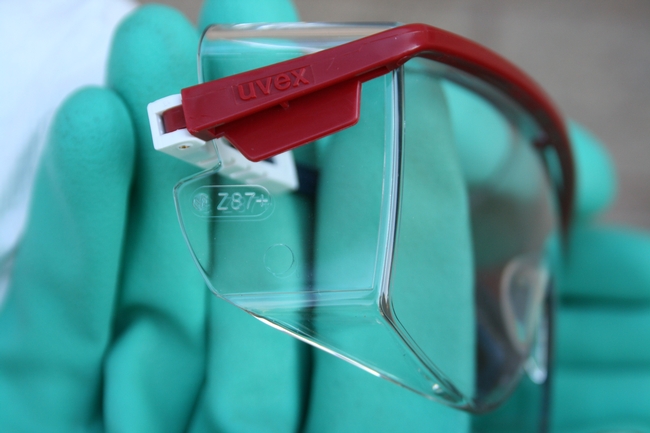When using any kind of pesticide, including herbicides, it's important to read the pesticide label carefully and to be sure that you have the proper equipment for applying the pesticide correctly and safely. You will need certain clothing to protect yourself from the unwanted effects of acute (immediate) and chronic (long-term) exposure, even when applying organic or lesser-toxic pesticides.
Personal protective equipment, or PPE, is the term used for clothing and eyewear that act as a barrier between your body and the pesticide. However, for home use pesticide products, PPE is not always listed on the label—some simply say to avoid contact with eyes, skin, or clothing. So how do you know what to wear?
Before using a pesticide
Know what the label says and what PPE you need before you handle, mix, or apply the pesticide. Minimally, protective gear should include chemical resistant gloves, eye protection, a long-sleeved shirt, long pants, socks, and closed-toed shoes.
Gloves: You must use the type of glove specified on the label.If the label does not specify that gloves are required, or if it only states that chemical-resistant or waterproof gloves are required, choose gloves of any chemical-resistant material. Avoid using cotton gardening gloves that may absorb the pesticide and result in prolonged contact with your skin.
Eyewear: Most home use pesticide labels do not specify what kinds of eyewear is required. If not specified, wear either a face shield, goggles, or safety glasses that provide front, side, and brow protection. All types of protective eyewear must be labeled “Z87.1” or “Z87+” (Figure 1) to indicate that it meets national protection standards.
Respirators: Most home use pesticides do not require a complicated fit-tested respirator, but you can use a NIOSH approved mask to reduce inhaling any pesticide dust, or particles. Appropriate masks will be rated with a code that includes either N, R, or P paired with a number. N95 is a very common one. Lightweight painter's masks may not provide enough protection. Again, check the pesticide label requirements.
Applying a pesticide and cleaning up after use
Ready-to-use (RTU) products usually come in trigger pump sprayers, shake containers, or aerosals and don't require special mixing equipment. Even when using RTU products, read the label first and wear PPE to limit your exposure to the chemical.
When using concentrated pesticides that need to be diluted before use, equipment such as a hand-pump compressed air sprayer may be needed. This type of spray equipment requires careful maintenance and operation as well as precise mixing of chemicals. PPE should be worn when handling, measuring, and applying the pesticide, as well as when cleaning the equipment after use.
After application, take a shower as soon as possible. Wash clothing separately from other laundry. Always wash your hands after spraying or handling a pesticide and before smoking, drinking, eating, or using the bathroom.
Remember to carefully read and follow instructions and equipment requirements stated on all labels. For more information about pesticides, see the list of resources on the UC IPM web page “Pesticides in homes and landscapes."
[Article originally published as "Wear the Right Gear When Using Pesticides" in the Summer 2019 issue of the Retail Nursery and Garden Center IPM Newsletter.]
Author - Associate Director for Urban & Community IPM/ Area Urban IPM Advisor
